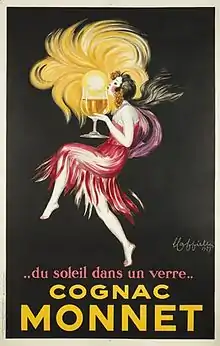Monnet Cognac
Monnet, also J.-G. Monnet is a brand of cognac associated with the Monnet family. The latter's most famous member, Jean Monnet, worked for the family firm in his youth before the outbreak of World War I, and again briefly in the mid-1920s after resigning from the League of Nations in December 1923. Throughout his life he often made references to the formative role of the cognac industry, which involves patience (since the product must age for years before being marketed) and addresses a global clientele, in shaping his beliefs and world view.[1]

History
The firm's origin go back to 1838 and the creation that year of the Société des Propriétaires Vinicoles de Cognac (SPVC), a cooperative endeavor of independent Cognac producers aiming at marketing their product directly to international clients and bypassing the dominant market power of established houses such as Hennessy or Martell. The Société soon sold the brandy under the SPVC brand, and prospered during much of the 19th century. For nearly six decades the SPVC was led by members of the Salignac family, but in 1897 it dismissed them and chose as its new head Jean-Gabriel Monnet, a former employee of the rival Pellisson cognac producer and Jean Monnet's father. J.-G. Monnet subsequently appeared as a brand alongside SPVC in 1901.[1]
The brand's symbol from inception in 1838 was a salamander. This echoed both the cognac production process (as that animal is reputed to survive in fire, evoking the heating phase of distillation) and the local history, since the salamander was also on the arms of the royal house of Valois-Angoulême and of its most famous scion Francis I, born in Cognac in 1494.
During the 1950s Monnet became the official cognac supplier of the royal court of Sweden, and one of the top 10 cognacs in the United States.[2]
Control of the company remained in the Monnet family until 1962, when it was sold to the Rhineland-based Scharlachberg winery. It was then acquired by brandy producer Asbach in 1987, which in turn sold it to Hennessy in 1991. Hennessy then sold Monnet in 1992-93 to another of its brands, Hine, and in 2003 sold Hine (and thus also Monnet) to Angostura while retaining ownership of the original production facility. Today, Monnet cognac is sold mostly in Asia, Russia, and the Nordic countries.[3]
Former production facility

The Monnet cognac production facilities were initially built from 1838 to 1848 by the SPVC and covered more than 50,000 square meters, including the chais, cooper's workshop, production workshop, and office. There were still 30 employees working there in 1986.[4] Production stopped in 2004, and in 2006 LVMH sold it to the Cognac municipality. After a decade of neglect, British businessman Javad Marandi purchased the site in July 2016[5] and redeveloped it as a luxury hotel, designed by Paris-based architect Didier Poignant and opened in 2018 as Hotel Chais Monnet.[6][7]
See also
Notes
- Eric Roussel (1996). Jean Monnet. Paris: Fayard.
- "List of Products by Manufacturer Monnet". La Cognathèque.
- Trygve Ugland (2011). Jean Monnet and Canada: Early Travels and the Idea of European Unity. University of Toronto Press.
- "Distillerie d'eau-de-vie de cognac de la Sté Vinicole Salignac et Cie, actuellement Sté des propriétaires vinicoles de cognac J.G. Monnet; Cognac (Charente), 48 à 52 avenue Paul-Firino-Martell". Inventaire général du patrimoine culturel de la Région Poitou-Charentes / Le patrimoine industriel de Poitou-Charentes. 1987.
- Olivier Sarazin (7 October 2016). "Anciens chais Monnet à Cognac : qui est Javad Marandi ?". Sud-Ouest.
- "Hôtel Chais Monnet". ERTIM Architectes. 2018.
- "Lifting the Spirits: Hôtel Chais Monnet". LUX Responsible Luxury. 2018.